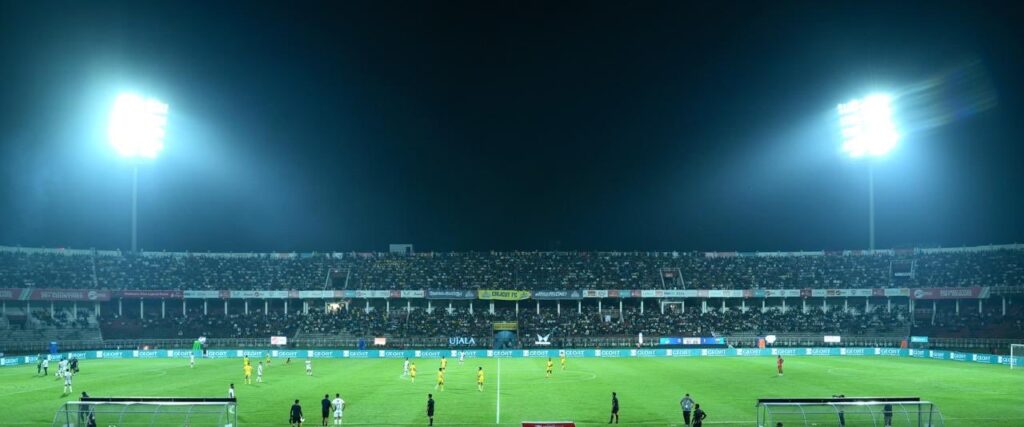Super League Kerala’s inaugural season is over and the dust has settled. The event was historic as no other state league in India has ever seen such a show and pomp. The combined venture by Scoreline Sports and Kerala FA managed to attract the eyeballs of football fans in God’s own country. This article will dissect the league under four headings: spectator response, game quality, broadcast, and involvement of corporates and public figures.
The Spectator Turnaround
Arguably the best positive of this tournament was the spectator turnout. On average, 8000 to 10,000 fans visited the stadium to watch the matches live. Malappuram and Kozhikode saw better crowds for their home matches, especially Malappuram. If the Thrissur Corporation Stadium and Jawahar Municipal Stadium can be renovated and the Kannur and Thrissur teams can be relocated, then attendance will improve next season. The way the Malappuram fans flocked to the stadium for their last home match, which was practically a knockout match, was a testimony of the football madness of Malappuram.

In the first season itself, we witnessed travelling fans’ culture. At all the stadiums, there were a considerable number of away fans.
Hosting the home games of Thiruvananthapuram Kombans at Chandrasekharan Nair Stadium turned out to be a good decision as the southerners exceeded the expectations of the organisers. It must be remembered that the organisers were reluctant to conduct the matches in Thiruvananthapuram. If it was not for the enthusiasm of the Kombans FC management, the people of south Kerala would have been deprived of the football action.
The question that needs to be answered is whether this kind of fan support can be maintained in the stadiums in the future or not. In the initial years of ISL, almost all teams had around 20,000 live spectators at the stadium which gradually dwindled over the years. The teams need to continue fan engagement and build solid community support to maintain the support.
Quality of Games
As most of the teams had former ISL or I-league foreign players and some Indian I-league players, the quality of the matches was good. Dorielton Gomes of Forca Kochi played for Bashundhara Kings last season and Alex Sanchez was the I-league top scorer last season. Joseba Beitia and Sergio Barboza also played in the previous season of the I-league. Indian heroes of yesteryears, C K Vineeth, Anas, Adil Khan, and Subhasish Roy Chowdhury, didn’t make much impact on the field. In some of the matches, however, the local players struggled to maintain the intensity during the final fifteen minutes. This didn’t come as a surprise as most of the local Kerala players are playing such high-intensity players along with foreigners for the first time. This league will provide a reality check for them and may act as a catalyst for them to work harder. Some of the matches had a similar quality as that of I-league matches.

The regulation that a minimum of five U21 Kerala players need to be in the squad was a well thought out one.
Can the teams continue to bring such quality players is the question to be answered. The average budget of the SLK teams is to the tune of 5 crores. If the teams can break even in the next 5 years, then they won’t hesitate to splash money to sign quality foreigners. However, if the support declines and losses accumulate, there will be cost-cutting measures as seen in some of the ISL teams.
As SLK is currently a standalone league, foreigners can be a part of the team. If SLK has to get integrated into the Indian football pyramid, then the foreign players need to be kept away from the XI. It will be interesting to see how that transition happens.
Broadcast
The tournament organisers did commendable work by roping in Star Sports as the broadcaster for the league. This is happening at a time when the second division of India is struggling to get a broadcaster. The matches had pre-match and mid-match discussions which are absent in the current season of the ISL. Almost 14,000 people were watching the matches live at any point in time.
There were official YouTube streams of live moments from the stadium before the match as well which also helped to increase the engagement. The highlights were available on YouTube within a few hours after the game.
Involvement of Corporates and Celebrities
Most of the teams had adequate numbers of sponsors and almost all were popular business firms and not surrogates of betting apps. The title sponsor was Mahindra and the popular milk product brand Amul was one of the main sponsors. Public figures like Prithviraj, Asif Ali, Sanju Samson, and Nivin Pauly did help to attract the audience.
Again, this was the case with ISL as well. Celebrities like Hrithik Roshan, Sachin, Varun Dhawan, Virat Kohli, Arjun Kapoor, and Abhishek Bachchan were part of the ISL teams. Some of them left and some of them are not actively involved in the club. Only time will tell whether the celebrities will continue to stick with SLK in the future or not.
Areas that can be improved
Separate home stadiums for Thrissur and Kannur teams should be an immediate priority. Without a home, the teams can’t have maximum community support. The renovation of the existing stadiums of Kannur and Thrissur needs to be initiated soon so that it can be completed before the next season.

The formation of reserve teams and participation of those teams in the KPL or other local tournaments. This will improve the player pool to choose from and avoid unnecessary inflation of the salary of the regional players in the future.
The branding of the league and advertisements can be displayed on the lower portion of the metallic grill in front of the lower tier of the gallery as done in the Indian Super League which will give a better visual appeal on television.


